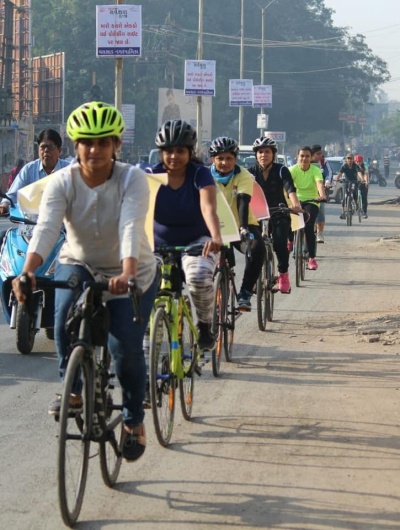In Copenhagen, which is globally acclaimed for its efforts to promote cycling, 55 per cent of regular cyclists is women. But in the United States, a recent study by the bike-sharing system Motivate indicated that fewer than 25% of the trips taken by bicycle this year are by women, indicating that there is a lot more to be done.
The gap is even greater in India. Women's workforce participation stood at 27 per cent in 2015-16, and in the knowledge sector, it was even higher, at 34 per cent. And yet, data from the #CycleToWork initiative shows that these percentages are not reflected in the numbers of women cycling to work.
#CycleToWork is a technology-powered campaign to document and encourage employees making work commutes by bicylce. Their rides to work and back are aggregated and published on a leaderboard which ranks the companies by the number of people bicycling to work, and by the number of trips they make on their cycles. The early interest is encouraging, but already the gender gap is visible; out of the 377 people who have signed up to the #CycleTowork platform so far, only 8.4 per cent are women riders.

A lot of women are considering it, but for now commuting to work by bicycle remains a rare choice.
What are the reasons for such a large gender gap? And what will make bicycles a more attractive commute option for women?
Shilpi Sahu works at Qualcomm, and she has clocked an average of 11 km on each of her trips. She says that while the number of women employees has increased in the company, there is a general aversion among women to taking up cycling - and some other activities - without consent from their families. Most women she has spoken to, and indeed some men, are cautioned not to ride by their family members because they view it as a risk to safety.
To compound this, says Shilpi, there is a lack of social acceptance of outdoor physical activities among women themselves. Plenty of women go to Zumba classes, gym and yoga, and run on a treadmill, but shy away from outdoor exercise. This could be for a number of reasons - a negative body image, fear of accidents, eve-teasing and harassment. And while there is no reason why traffic and pollution should affect women more than men, Shilpi says women face extra harassment by some road users who have a bias against women riding/driving on the roads. Shilpi says she herself has not been a victim of any harassment though. The solution, she says, is to change mindsets and social acceptance.
I spoke to Vidya Chandran on gender diversity. She is an avid cyclist and a member of a few cycling clubs. She's also thought about the gender disparity in cycling, which led her to form an all-women cycling club called Spokes Women. She agrees with a lot of what Shilpa Sahu had to say - that the most common issues in the way of women choosing cycling are safety, pollution, the risk of encountering mechanical issues, and widespread disregard for cyclists among the public. To be sure, these are things that all cyclists face, men and women. but coupled with the reasons that apply particularly to women, these are big factors.
Contrast that with running, another sport that is slowly emerging in India, and is one where significant numbers of participants are women. In a lot of the road events for running, including the longer runs, nearly half the participants are women. That, however, may be partly because running is not woven into the everyday lives of people, and most runners look for events to run in. Cycling, on the other hand, needs to be something they can do daily.
And in this, women start with obstacles to overcome. Vidya Chandran points out that there isn't enough support for women commuting to work by bicycles. With long hair, makeup, and a wider repertoire of apparel, Indian women need better changing and shower facilities as an important incentive, she says. This is woefully lacking in most Indian offices. She has found that the more women ride, the more comfortable they get with handling issues on the road. This is true for men as well, she concedes. The more one does it, the more one's comfort with it.
One area in which the government needs to do more is to provide better support for women who are harassed on the roads. A lot of this goes unreported, so #CycleToWork has launched a #Motorage hashtag on social media for people on a bicycle to report harassment. It also has a page where people can report these incidents anonymously on the website at https://cycleto.work/motorage. These options could help surface incidents of harassment and bring them to the attention of the public and authorities.
There's no doubt that women cyclists are still pedalling uphill, against social and economic factors that are often beyond their control. A concerted effort by society and governments will be needed to make regular cycling an acceptable option for more women. The few who have already donned their helmets and mounted their bikes are hopeful that their examples will be emulated by many others, and that as more and more women riders appear on the streets, governments will have to discard their inertia.
























